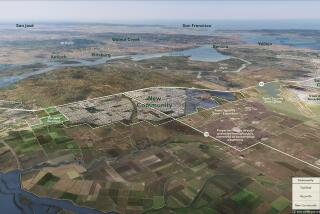Spotlight on Rival Initiatives : Slow-Growth Issue Colors Carlsbad City Council Race
- Share via
It was to be the end-all, the weightiest of elections in Carlsbad, the litmus test to determine just how the community would address the pressing issue of growth.
But it didn’t work out that way.
Indeed, the November contest between two competing ballot measures designed to control the city’s development boom produced murky results at best.
Both measures got a majority vote, with the City Council-backed measure declared the winner because it received a larger share. Irked by that, supporters of the rival slow-growth initiative took the matter to court, where it is expected to be decided in April.
Now, the growth issue has spilled over into the race between two candidates for a key City Council seat up for grabs in a March 3 special election. The spot was vacated in November when Claude (Buddy) Lewis moved up to the mayor’s post.
As many local activists view it, the contest is a pivotal event that could prove just as important as the on-going battle between the initiatives, coloring the council’s posture on growth for years to come. It shares the ballot with a proposal to spend $7 million to purchase the endangered Hosp Grove.
On one side in the council race is Albert Mendoza, a devout slow-growther and treasurer of Concerned Citizens, the grass-roots group that helped sponsor Proposition G, the tough growth-control initiative that proposed a strict cap on housing construction in Carlsbad.
His sole opponent is Eric Larson, a former city planning commissioner and self-described moderate on the growth issue. In November, Larson supported Proposition E, the council-sponsored ballot measure designed to ease the effects of growth by insuring that public facilities keep pace with development.
As slow-growth advocates see it, a victory by Larson could sharply sway the council’s direction in its week-to-week implementation of existing planning policies and laws. They have tried to paint Larson as a pro-growther, in particular because the 37-year-old father of two was endorsed and supported by the local Building Industry Assn. when he finished fifth in the November race for two seats on the council.
Mendoza, meanwhile, has an established track record as an opponent of unchecked development, slow growthers say. In addition, he has promised to push for council approval of an annual cap on housing construction similar to Proposition G if the ballot measure does not prevail in court.
Finally, they contend that Mendoza, if elected, would team with Councilman Mark Pettine, a devoted slow-growther, to form a coalition that could woo swing votes like Mayor Lewis and, potentially, Councilwoman Ann Kulchin. The slow-growth advocates say that only Councilman John Mamaux seems out of reach.
“This election is extremely important,” said Mendoza, a retired district administrator with the state Employment Development Department. “If Mr. Larson wins, it could easily shift the council back to the old philosophies of uncontrolled growth.”
His supporters agree.
“Mr. Mendoza would support any reasonable measure that would give us slow growth,” said Nelson Aldrich, co-chairman of Concerned Citizens and a Mendoza supporter. “On the other hand, I don’t think Mr. Larson is a slow-growther. And if you’re not for slow growth, then you must be for growth.”
Such logic irritates Larson and his supporters.
“I’m a moderate. I’m a real proponent of controlled growth,” said Larson, general manager of a Carlsbad-based firm that auctions plants and flowers to retail outlets. “The pro-growth days in Carlsbad are over. We don’t have a pro-growth council now and we wouldn’t with me on it. We’d have a sincere, controlled-growth City Council.”
He maintains the city is currently working to control the effects of rampant development with the passage of Proposition E and the council’s adoption of a growth management plan last year. Putting an artificial cap on the number of homes built each year, as proposed by slow-growth advocates like Mendoza, only “takes the city out of the business of planning,” Larson said.
Larson insists he never sought help from the Building Industry Assn. in the November election. Nonetheless, BIA officials say the group provided $1,136 in assistance for Larson, primarily in the form of “get-out-the-vote” telephone calls.
This time around, Larson said he did not even bother seeking an endorsement from the BIA.
Mike Reynolds, president of the BIA, said no “formal proposal has been before our board to endorse or financially support” Larson. In fact, he said the group may begin shying away from formal public endorsements of candidates, in particular because “I don’t think it does a candidate any good to have an endorsement from the BIA.”
But Reynolds noted that many members of the association “have thoughts and ideas as to who they support and will work to support those individuals.”
Mendoza, meanwhile, predicts that “big money” from the development industry will ultimately find its way to Larson’s campaign, primarily because builders do not want to see another avowed slow-growther elected in Carlsbad.
“This seat is important to them,” he said. “This is a key seat and they mean to have it.”
According to campaign expense reports on file at Carlsbad City Hall, Larson has gotten about $4,500 in contributions as of Feb. 19. He’s spent about $2,000 of that and predicts he will ultimately spend between $6,000 and $8,000 on the race.
Mendoza has gotten more than $6,000 in contributions and spent about $2,000 of it as of Feb. 19, the disclosure forms indicated. Mendoza said his campaign would probably cost more than $6,000.
Both candidates have been walking door-to-door to meet voters. In addition, they plan mass mailings of campaign literature and have lined the city streets with placards.
During debates in recent weeks, the two candidates have tussled over several issues, among them Mendoza’s proposal for a $250 limit on campaign contributions. Larson countered that he found it puzzling his opponent had called for the contribution limit then accepted a $1,000 donation from Concerned Citizens.
Larson has also scored Mendoza for not having any experience on any city committees or commissions. In addition, he has noted that Mendoza has lived in Carlsbad for about four years and questioned his devotion to the community. Larson is a native of Encinitas and has lived in Carlsbad since 1971.
Time and again, however, the debate has returned to the issue of growth. And, although both candidates agree that growth is a problem, they find little common ground beyond that.
Larson said the city’s growth-management plan, in concert with the provisions of Proposition E, has already worked to slow the pace of development in the city. By assuring that public services such as streets, parks and sewer lines are provided for, he said, the city’s current efforts will help alleviate the effects of growth on residents.
“When anyone complains about growth, they’re complaining about the price they have to pay,” Larson said. “They’re complaining about not having a field for their kids soccer team to play on or about being stuck in traffic. That’s the bottom line when it comes to growth.”
But if a cap were put on growth, as Mendoza proposes, the facilities that are needed right now could not be provided, Larson predicts.
“I see the two concepts as being incompatible,” he said. “If you don’t allow some growth, developers can’t fund the services and facilities we need. Developers are our method for solving problems with overcrowded streets, a lack of parks and other problems.”
That sort of reasoning troubles Mendoza. He insists that the city’s existing growth management program would work harmoniously with an annual cap on construction. Under Proposition G, development would be limited to 1,000 dwelling units in 1977, 750 in 1988 and 500 a year until 1996.
Mendoza said such limits would give residents “a 10-year respite, time to plan the city we want.” The other option, he said, would be to sit back and watch as developers carpet the hillsides with a hodgepodge of housing.
“I want to make Carlsbad a 21st Century city,” Mendoza said. “We should plan and design it and built it and know what it’s going to look like when it’s built out. We should try to avoid the pitfalls of the past. We only have one chance. We need to do it right the first time.”
He complained that Larson is simply asking the public to trust elected officials to do the job of slowing growth. Mendoza said he prefers unbending limits such as those proposed by Proposition G.
“People like Mr. Larson are saying, ‘Trust me, I’ll do it,’ ” Mendoza said. “But what guarantee is he giving the people that growth will slow? A promise?”
More to Read
Sign up for Essential California
The most important California stories and recommendations in your inbox every morning.
You may occasionally receive promotional content from the Los Angeles Times.










